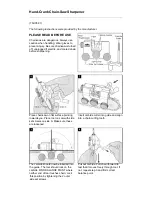
15
(1) Upward movement (2) Reversing (3) Downward movement (4) Impact
(1) Upward movement
Oil flows into chambers 1 and 8: the control valve is pressed in the downward direction.
The piston moves in the upward direction toward the cushion chamber 5.
Oil in the opposite chamber 4 is discharged through the control valve into chamber 7.
(2)
Reversing direction
When the lower flange fills with oil, it reaches camber 2. At this point both chamber 6 and 8
exert the same pressure on the flange but the control valve moves in the upward direction
due to the area difference between the flanges.
(3) Downward movement
When the control valve rises and reaches chamber 8, the flow moves through control valve
and reaches chamber 4.
Due to the difference in area between the piston flange and the force from the cushion
chamber pressure, the piston accelerates downwards.
(4) Impact
The piston hits the chisel. At this point the mid-section of the piston reaches chamber 2 and
as a result chamber 6 releases the pressure through chamber 2 and 3.
When chamber 6 is empty, as chamber 8 is constantly pressurized, the valve moves in the
downward direction.
Repetition of the cycle mentioned above results in continuous blows.
TNB-6M, 6E, 7J, 16K/
110
, 141LU, 151LU2,
27K/
190LU2
, 230LU2, 310LU1, 60K/
400LU2
Summary of Contents for TNB-08M
Page 133: ...TOKU Pneumatic Co Ltd...
















































